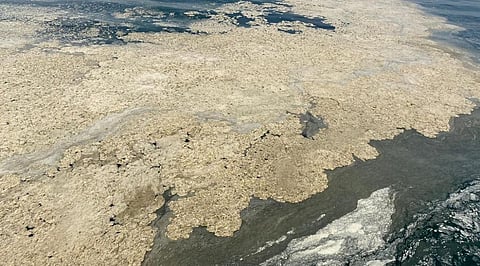

Turkey should mitigate the growth of factors that have been responsible for the biggest-ever outbreak of sea snot or marine mucilage in its Sea of Marmara, an Indian expert has said.
Instead of trying to ‘clean up’ the inland sea that separates the European and Asian parts of Turkey, the country should take steps like limiting the flow of nutrients into rivers at the source, Manish Kumar, a professor at the Indian Institute of Technology, Gandhinagar, told Down To Earth.
“Our suggestion would be to mitigate the causes which are aiding in the formation of sea snot rather than looking for an immediate solution in terms of sea cleaning. These problems are primarily due to human activity on the land,” Kumar said.
Limiting the nutrient inflow into the rivers will, however, require a multi-level risk assessment approach where continuous monitoring of coastal and river water will have to be undertaken on a weekly basis, Kumar added.
Sea snot has also been seen in the adjoining Black Sea and Greece’s Aegean Sea, which are connected by the Sea of Marmara through the straits of Bosporus and Dardanelles.
Kumar’s comments were in response to the Turkish government’s ongoing clean-up drive announced by its environment minister. Turkey’s President Recep Tayyip Erdogan has said, “We will save our seas from this mucilage calamity.”
But what exactly is sea snot? It was first discovered in Turkey in 2007. Also known as ‘marine mucilage’, it is a thick, slimy grey-brown sheet that is formed by dead and living organic material. The sludge forms when algae overloaded with nutrients fests on warm weather. This warm weather is caused due to global warming.
Algae are the prime source of oxygen in water bodies. However, if their growth is overlooked, they could lead to the formation of this mucilage that could block sunlight from entering the deep waters of the oceans.
The current outbreak has made it difficult for marine and aquatic life to survive beneath water. It has also affected local communities on a large scale. Some of the sea snot has sunk below the water surface, suffocating the seabed. The proliferation of the organic matter can also flourish when nutrient-rich sewage flows into seawater as it contains a wide variety of micro-organisms.
Kumar said oceans played a major role in sustaining the global economy, livelihoods as well as maintaining climate feedback channels. However, the ocean biogeochemical cycle was majorly dependent upon plankton species like ‘coccolithophores’ that helped in calcifying carbon dioxide from the atmosphere.
This process sequestrated atmospheric carbon dioxide and thereby helped in preventing immediate shocks of climate change. Other plankton species like diatoms helped in photosynthesis and provided food to almost a sixth of the ocean.
Cyanobacteria and chlorophytes had a significant role in nitrogen recycling. However, their deaths resulted in the formation of detritus that provided an active site for the formation of sea snot.
“A major concern is that the enhanced growth of sea snot through nutrient enrichment in the oceans will prevent the recycling of silica, nitrogen and carbon for the ultimate growth of plankton and micro-organisms, thereby disrupting the entire ocean biogeochemical cycle,” Kumar said.
He warned that Indian waters too could experience extreme events like a sea snot outbreak in the future.
“The ocean biogeochemical cycle is still a vastly unexplored field. Therefore, there is a dire need to develop a system of monitoring to regulate the nutrient flow from landforms into the oceans,” Kumar said.